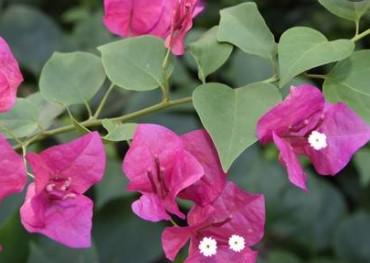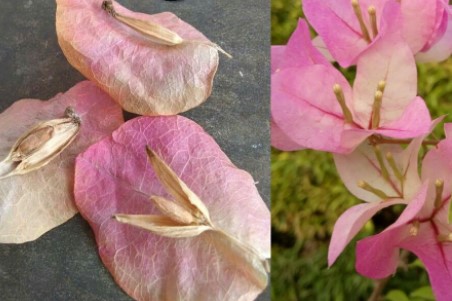Love adding colors to your garden with the beautiful plants that grow a variety of flowers and produce fresh fragrances? Then bougainvillea is the best option that gives a splendid appearance to the garden and a feeling of freshness to the visitor. The flowers that are in bloom have a sweet fragrance with a variety of colors.
Bougainvillea plant needs the proper care for growing as it is not an easy plant to grow. Bougainvillea needs proper sunlight of about 4-5 hours for blooming. The proper amount of water vapor from the atmosphere also makes the plant fresh and bloomy.
So what’s the proper way of growing bougainvillea? Bougainvillea can be grown in two ways, by seeds and cuttings. Here is a quick method on how to propagate a bougainvillea plant with proper steps.
Contents
- How to Propagate Bougainvillea
- Mature Stem
- Cut Leaves
- Rooting Hormone
- Plantation
- Inserting
- Moisturizing the Plant
- Covering the Pod
- Sprouting
- Seed Propagation Method
- When to propagate Bougainvillea?
- Growth of Bougainvillea
- Transplanting of propagate Bougainvillea
- Appearance of Leaves
- Sunlight Exposure
- Temperature Regulation
- Transplanting
- Conditions to Grow Bougainvillea
- Season of Propagating Bougainvillea
- FAQs
- Can you grow bougainvillea from a cutting?
- What is the best fertilizer for bougainvillea?
- Can bougainvillea grow in the shade?
- Conclusion
How to Propagate Bougainvillea
The two simple methods for propagating bougainvillea are by cutting and seeding. Propagation of this plant is more commonly done through cutting. Seeding is less commonly used.
Propagating Bougainvillea by Cutting
Growing bougainvillea is mostly done by cutting the mature stem for propagation. The proper process of propagation includes the following steps.
Mature Stem
Take a cutting of a mature stem from the plant at least a length of 6-8 inches. For best cutting results, the pruning shears must be sharp. The cuttings must be healthy, fresh, and free from infections and diseases. The cutting of the stem should be correct, which increases the surface area and allows the stem to take nutrients and water vapors from the soil.
The roots of this plant are susceptible so that you might fail at your first attempt. For the best results, prefer the woody part of the stem and take the cuttings carefully. Avoid taking the young sections of the stem, mainly the greenish part. 7 nodes must be there on a stem for the healthy productivity of a plant.
Cut Leaves
For a successful result, the leaves must be pruned from the stem to reach the root perfectly. All the leaves, flowers, and other side branches must be removed from the stem. Remove all the green areas so that the woody part remains most prominent. The greenish part does not give effective results, and it is less likely to survive.

The removal of the leaves allows the stem to take all the required moisture from the soil. Nutrition and moisture are essential and beneficial for the growth of fine roots. To avoid drying and for later use, put the cuttings in a plastic bag and store them in the refrigerator to keep them fresh.
Rooting Hormone
To improve the number of roots, put the bottom of the stem into the rooting hormone powder. The coating should be properly done and avoid making a mess. Tap the stem gently in case there is too much clumping.
Rooting hormone (rooting acid) can be found in plant nurseries, gardening centers, and greenhouses. Rooting acids are best for growing healthy roots, which reduces the dryness and prevents the root from dying. Rooting hormones can also be made at home by using the available ingredients like honey, apple cider vinegar, cinnamon, and crushed aspirin.
Plantation
Take a small pot that has well-drained soil, which is sufficient for the roots to absorb oxygen and moisture from it. The design of the pot should be medium-sized so that the propagation of cutting gives the best result. ¼ inches of space should be left from the above pot for the water entrance.
Use the porous substance while using the garden soil for proper drainage of water. The pot size should be ideal for the proper growth of the roots. The roots are very subtle and can break easily, so they need extra care.
Inserting
The cutting should be inserted in a way that it does not break and fits in properly. If the soil is a bit thick, then first make a hole before inserting the cutting stem. This will prevent damage and breaking of the stem. The angle of inserting should be in a way that the nodes germinate into the roots.
Moisturizing the Plant
Proper watering of plants will moisten the soil's surface, which provides better nourishment to the plant. Healthy water intake will let the roots grow properly and provide a strong root system to the plant.
Too much water will weaken the roots, and hence it will inhibit the growth of the plant. Excessiveness of moisture is harmful to fungal and other root diseases. More leaves growth will be noticed as compared to flowers.
Covering the Pod
Covering the pod will give a greenhouse effect to the plant, which helps trap moisture and humidity. An abundant amount of moisture will allow rapid plant growth. Avoid direct sunlight and keep the pot cool and under low temperature. The plastic bag should be sealed properly, securing the bottom of the pot.
Sprouting
It takes 6-10 weeks for the cutting to sprout and experience the growth of new parts of the plant. The growth of the plant begins when the new leaves arise on the stem. Do not remove the bag at the time of sprouting; avoid interrupting the plant. This can lead to inhibition of plant growth. Better wait for the proper growth of the plant until it fully branches.
Seed Propagation Method
Finding the proper seeds for the propagation of bougainvillea is very tricky. Well-established plants are required which provide the proper seeds. Check for the leaves that have more colorful flowers around. Let the bract dry, and it will probably take a month to ripen. The three pods inside the bract contain the seed.

The seeds should be round and brown in color. The seed inside the pods should be gently removed. Fresh seeds are easier to remove than the ones which are more tightened in the pods.
The soil must be well-drained for the propagation of the seed. The container should not be narrow from the top. For proper sunlight, the container should be kept in an area that directs the light into it. The heat should be bearable to the seed, which needs proper adjustment of the container.
The seeds of bougainvillea should be spread on the surface of the soil but not at much depth. Water the seeds and wait for the sprouting as it takes a long time (a month). But it gives worthy results.
When to propagate Bougainvillea?
The speedy and most abundant growth of the Bougainvillea plant occurs from late spring to mid-summer. This is the time the bud nodes swell, which gives rise to the branches, leaves, buds, and flowers.
Growth of Bougainvillea
The Bougainvillea growth is inclusive and is 20-30 feet tall. The tallness of this plant is 1-½- 2 inches and 8-10 feet wide. Dwarf sizes are also available, which are 3-6 feet wide and big.
Transplanting of propagate Bougainvillea
Root damage mainly occurs while transplanting the bougainvillea plant. To prevent root damage, water the plant properly. Transplanting should be in an area where there is proper sun exposure. Transplanting of Bougainvillea needs the following steps.
Appearance of Leaves
Rooting of the cut stem should be continued until the emergence of leaves. This process might take some months (3-6) depending on the soil conditions and the cutting of the stem. Once the green leaves appear, you can safely transplant the stem into the garden or in a container.
Sunlight Exposure
The rooting cut stem must be exposed to bright sunlight. Most gardeners recommend this because the plant gets used to the environment in which it is transplanted. This phase takes at least 2 weeks, during which the plant responds to the change in the environment. Direct sunlight exposure will help the plant to acclimate and increase its survival for proper growth.
Temperature Regulation
During this time, you need to regulate the temperature of the transplanted stem. During the hottest part of the day (afternoon), bring the pot inside, and after sunset, bring it back. Young cuttings are sensitive and rapid changes in temperature cannot be safe for the plant. The best temperature for bougainvillea is room temperature because it suits them best at human temperature.
Transplanting
The plant is now ready to establish itself in the garden. The roots should be forced out gently from the compressed soil. Take the pot in your hands carefully, and the cuttings should be held in the opposite hand. The plant should be planted in a garden, and now it's ready to grow on its own.
Conditions to Grow Bougainvillea
The condition to grow bougainvillea plant requires:
- Proper sunlight of 6-8 hours produces a variety of colors for the plant.
- Well-drained soil is essential for promoting a healthy plant.
- Regulation of temperature is significant for the survival of the plant.
- The use of fertilizers like nitrogen, phosphorous, and potassium will promote a healthy plant with plenty of flowers.
- Training to climb a wall or framework doors by fine wires and directing the plant in a proper direction to spread and present a beautiful look.
Season of Propagating Bougainvillea
The best season for propagating Bougainvillea is late spring to mid-summer. Winter is not a good time for propagating bougainvillea because, in winter, the stem loses its green leaves. The springtime and mid-summer is the best time to harvest plants; at this stage, the plant growth is very rapid.
FAQs
Can you grow bougainvillea from a cutting?
What is the best fertilizer for bougainvillea?
Can bougainvillea grow in the shade?
Conclusion
To make your garden even more colorful and eye-catching, you need to add colors to it. Plants that cover your walls with freshly bloomed flowers and pleasing fragrances give an amazing feeling. Go and get the bougainvillea plant for an amazing experience and beautiful look where the pleasant smell of flowers refreshes the soul.

